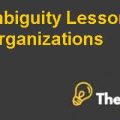The Armenia Earthquake Case Study Solution
Abstract
The case “The Armenia Earthquake: Grinding Out An Effective Disaster Reponses In Columbia’s Coffee Region” is completely based on the problems that could be faced by a city or a country when any natural disaster hits a business hub or important place of a respective city.An example of Armenia Earthquake has been presented to show that how it was impossible for different organizations to work and manage these issues being faced by the people.
The devastation caused many problems to transportation, financing, human resources and other departments which were very difficult to solve. As a result, few initial days were highly tensed and many people were left hungry as there was no effective supply chain policy being used by the government.
In this report, alternatives have been presented that can be used to solve the issues that have been faced by Armenia. Moreover, decision criteria have also been developed that would be useful for selecting a solution. Lastly, one of the alternatives has been selected as recommendation presented to the government.
Introduction
This case mainly describes the supply chain issues that take place in initial seventy-two hours when a country or a city faces a risky natural disaster on a large scale. In this case, Armenia Earthquake has been taken as an example to show how different response systems have worked parallel in order to face this situation and solve the problems.
On 29 January, an earthquake with the measurement of 6.0 took place. The main rescuers, police and fire department failed to manage this disaster. Moreover, 300 aftershocks also occurred, which created additional destruction in the city and caused communication failures.
Government of Columbia had already developed the national disaster systems in order to respond disasters. However, at the time of earthquake, the responses of local and regional committees were very weak. On the other hand, Columbia had the experience for reacting to disasters due to the armed conflicts. Government agencies and the Red Cross had learnt many languages of disaster management between the time span of 1985 and 1995.
As the earthquake took place, it was analyzed that the the initial and urgent requirements were shelter, food and water. An exhibition center, CENEXPO, has been used as the first shelter place as its parking lot was larger and less destroyed. The money that has been spent by rescue teams came from several sources such as National Food for Calamities, Social Solidarity Network, ICBF and Red Cross and RedCrescent Societies. In addition, there were many local and international volunteers available for helping the affected people and were ready to do any type of work.
It has been decided by the president that initial coordination of the response would be taken by National Disaster Management Office and RSS. However, it was declared that there was lack of disaster management experience which created violence. On the other hand, 300 extra men were added to 2000 troops already working. Red Cross also assigned an admin employee to take care of money and personnel.
In order to make donations, few reception points in different Columbian cities were developed where many public and private sectors companies have donated generously transportation services and goods in large quantities. However, it also created few problems as expired medicines and very low quality food items which were harmful were donated. Moreover, after three days of earthquake, international donations were also arriving. Red Cross was using its own ways of gathering international donations and was getting donations faster than other organizations.
The transportation system such as roads and airports were also destroyed badly. As a result, it was known by the president that aids were not being received by the affected people. After arrival, it was known that aid was held at warehouse and the airport did not have time for operations as it was not authorized and there was no payment for fuel. However, after 24 hours, the service was revealed. In addition, the transportation services from local or regional government started to arrive. Consequently, there were 350 ambulances on the third day.
On the third day, it was announced to take food from Red Cross who served it accordingly.However, it also created panic and people broke towards ware house.Due to the panic, lack of reliable knowledge and uncertainty of the population, the situation led to failing of aid arrivals, which resulted in looting.
The Armenia Earthquake Harvard Case Solution & Analysis
As a result, it was analyzed that due to lack of controlling and management of government resources and internal government affairs, the administrative processes were being difficult.
Lastly, it has been analyzed that there were some conflicts between national, regional and local agencies. On the fourth day, organizations were improving and president settled the dispute between agencies and organizations.On. the fifth day, the fund was gathered for reconstruction for coffee region. FOREC organization was selected for financial and admin management of reconstruction process. The organization worked so well that after a year, FOREC organization received award for Disaster Reduction. In addition, the United Nations also honored FOREC for its hard work...................
This is just a sample partial work. Please place the order on the website to get your own originally done case solution.











